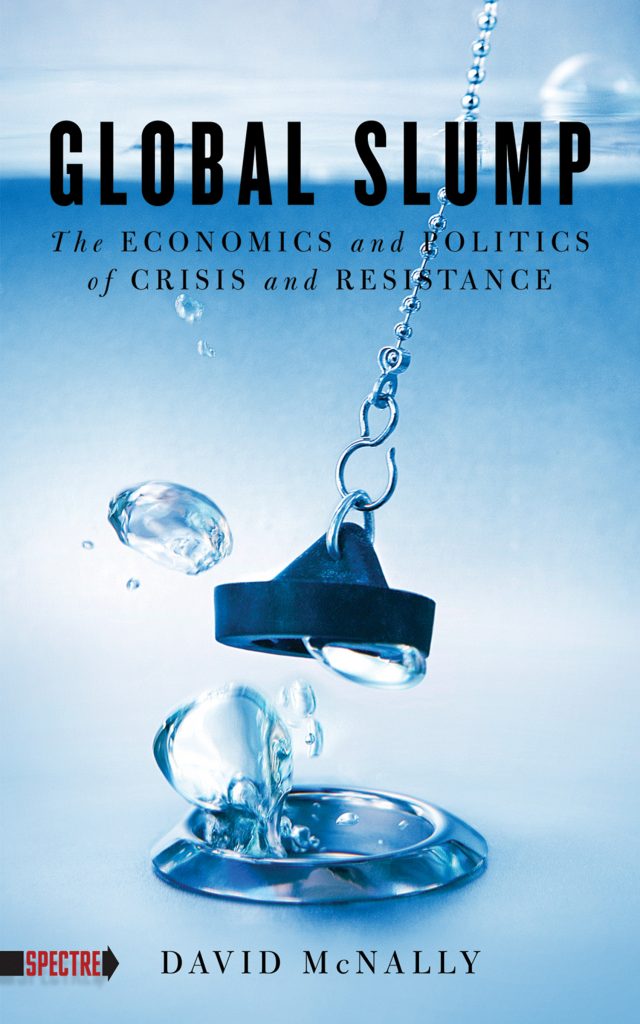by Seth Sandronsky
Z Magazine
January 2012
Beware the recovery from the downturn of 2007-2008, as tens of millions of people hang on and fall down. Their daily lives have differences and similarities. One of the former is place: the global south or global north. Chinese women assembling goods for export face labor conditions that female WalMart “associates” stateside don’t. But as women waged workers, they share similar relations with bosses and capitalist-friendly governments that back lower wages and weak environmental oversight as a lever for higher profits in a worldwide system. To get a deeper grasp of this process requires an analytic context to untangle the varied antagonisms that people experience in an era of turmoil for all but a wealthy few. To this end, David McNally, in Global Slump: The Economics and Politics of Crisis and Resistance (PM Press, 2011), sheds useful light on what is at stake and why.
McNally’s first chapter surveys the 2008 panic that radiated shockwaves around the world. As he documents, the financial damage began in early 2007 with HSBC Holdings losing $11 billion in home mortgage investments. The author explains how the blowing of an $8 trillion U.S. housing bubble hammered private-sector demand and led to a government bailout of big Wall St. banks, mostly, with the Obama stimulus package also flowing, too little too late for Main St. Crucially, with increased deficit spending from rescuing major financial players (“too big to fail”), governments worldwide are trying to exit the 2008 crisis with cuts to government spending.
In McNally’s narrative, there is a bi-partisan political move (i.e., GOP and Democrats in the U.S.; Labor and Tories in the UK) to cut such deficits. This is how, in part, the system, with a visible hand from the governments upon which it relies to grow, purges excess production in goods and services. The aim is to create the conditions for improved return on investment.
McNally writes on behalf of those who are the least at fault for the crash and are in the crosshairs of a “decade of pain,” thanks to government policies, e.g., budget austerity, that will reduce their living and working standards unless, of course, they can organize and mobilize for alternate policies. Such actions, he writes, involves “understanding the mechanisms capitalism uses to get out of crisis . . . an intellectual task of the greatest urgency.”
Think that Marxists such as McNally sing in the same voice about capitalism’s tendencies to crisis? Well, think again. He parts ways with, for example, Robert Brenner over the end of postwar prosperity in the 1970s and the next quarter-century before the Great Recession, or the era of neoliberalism. In contrast to Brenner, who holds that capitalism entered a “long downturn” in the early 1970s, McNally maintains that industries maintained profitable growth when that post-war period ended in part through workplace restructuring like “lean production.” Take U.S. steel industrialists. They used technological means along with anti-union approaches and work speed-ups to wring profits and growth from their work forces. To be sure, capital flight to the Global South was and is part of that changing structure.
McNally, following Marx, has a two-fold definition of capital. It is the means of production, or factories, offices and machinery. At the same time, capital is a social relation of waged-laborers and their bosses. Each depends on buying and selling commodities—both people’s energy and the goods and services they create at work—in the marketplace to survive another day in a competitive and class-driven system. Against this backdrop, McNally historically situates the rising role of financial capitalism in President Nixon’s ending of the Bretton Woods post-war monetary arrangement. In effect, he decoupled the greenback from its gold backing and let the dollar “float” to its fluid price on world markets. Later, global financial speculation exploded. Wages stagnated. Debt skyrocketed. In the global north, (dis)organized workers would get credit lines instead of wage raises over the next twenty-five years. In brief, this toxic brew sparked social inequality. In the history of capitalism, this gap breeds systemic instability.
McNally focuses closely on the gender and racial oppression built into capitalism. This is a major strength of his book. Further, he surveys popular resistance movements, from China to Mexico, Guadeloupe, Martinique, France and the United States. The role of the U.S. military in enforcing the economic rule of American capital is sparse. Yet McNally has, concisely, delivered a radical description of a crippled and crippling social system. His prescription for a way of living that puts people first is clear-eyed and empowering for readers.







